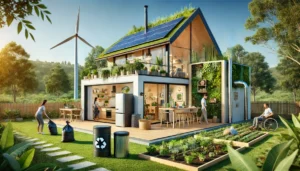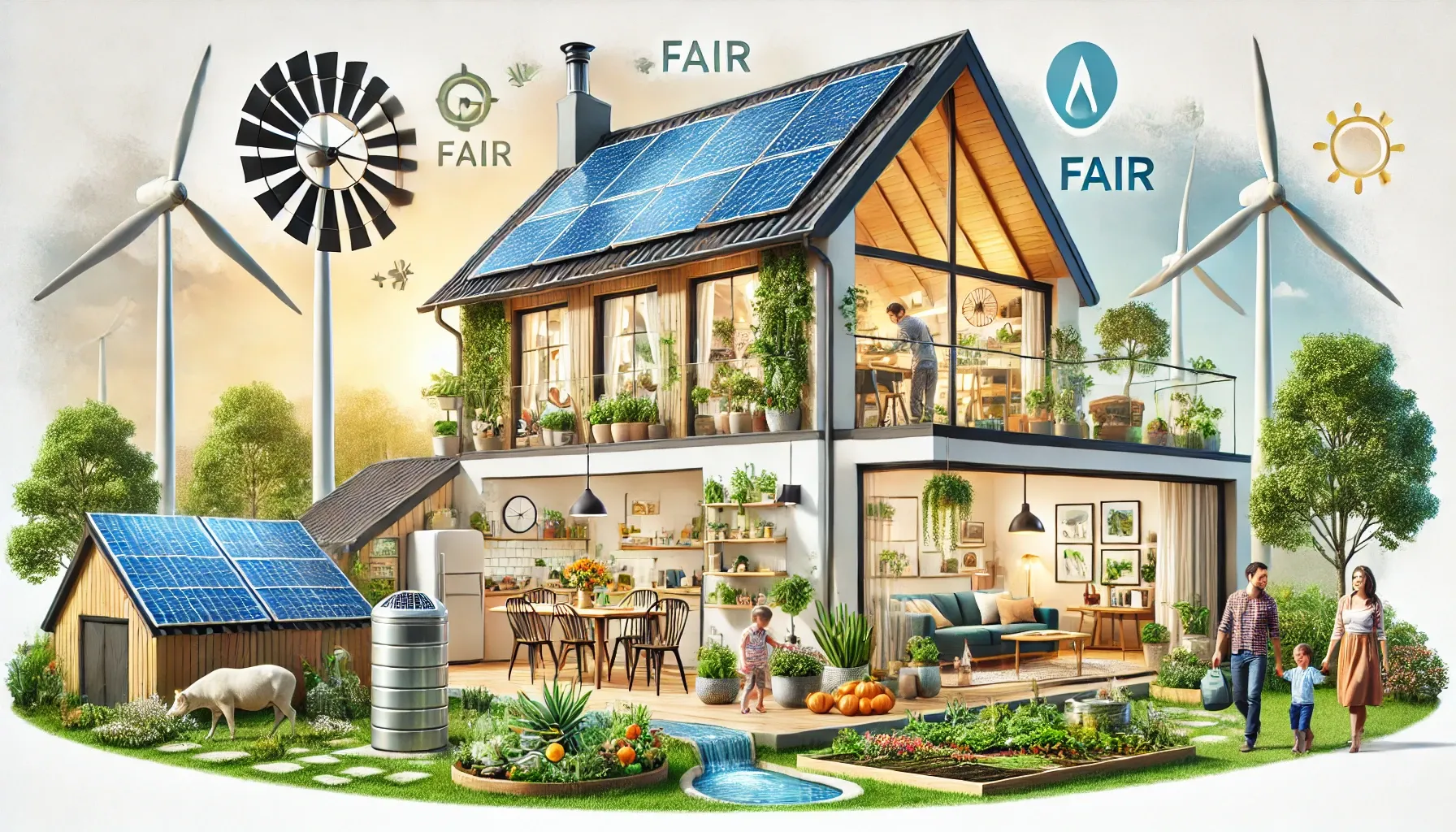Introduction
With climate change and environmental degradation emerging as some of the most critical global issues, delivering an affordable neutral carbon home becomes a requirement rather than just tapping into a trend. The focus of this article will be on how you can make your home a green fortress – or at least reduce your carbon footprint and promote sustainability and fairness.
Carbon Neutrality Explained
Carbon neutrality (a.k.a., having a net-zero carbon footprint) can be achieved by balancing the amount of CO2 emissions released to the atmosphere with an equal level offset or reaching zero through other techniques that take out as much as was produced. Having a carbon-neutral home means not just consuming less, but using types of energy and products that produce near-zero or zero net greenhouse gas emissions.

Fairness in Sustainable Living
Part of what it means to think about fairness in sustainability is not trying to cut your carbon emissions but only doing so at the most vulnerable, necessarily. This encompasses principles of fair trade practices, shopping locally, and living in a way that the culture is feeding into itself with your choices wherever possible.
How to Have A Carbon Neutral Home
1. Energy Efficiency
It forms the base of any carbon-neutral house. Ways to save energy include:
- Insulation: Insulating well can reduce the need for heating and cooling. Wall, roof, and floor insulation keep indoor temperatures consistent.
- Windows: Better insulation, double-glazed windows reduce energy loss.
- Lighting: LED bulbs are more energy-efficient and last longer than incandescent.
- Energy Star-rated Appliances: Select energy star appliances as they consume less electricity and are more ecological.
- Smart Thermostats: This is for your older wired HVAC systems but people are installing programmable thermostats that save energy when you really just don’t need to cool or heat the house.
2. Renewable Energy Sources
Moving to clean, renewable energy is essential in every carbon-neutral home:
- Photovoltaic Panels: Installation of solar panels can help reduce dependency on fossil fuels at a significant level. This is carbon-free, renewable solar energy that can be used in your home.
- Wind Turbines: If you live in a windy area, small wind turbines are another option for generating your own electricity.
- Geothermal Systems: Geothermal heating and cooling systems take advantage of the stable ground temperature that sits just below your feet to bring about cost-effective comfort for homes.
- Community Energy Programs: Join a renewable energy program in your local area, this allows you to buy power from clean sources.
3. Water Conservation
Water efficiency is an important part of reducing the carbon footprint of your home.
- Low-flow fixtures: Change out existing faucets and showerheads to low-flow models, install a dual-flush or additional-efficient toilet.
- Rainwater Harvesting: Gather and store rain for landscape irrigation and other outdoor non-potable purposes.
- Greywater Kits: Use water from baths, sinks, and washing machines for irrigation.
- Smart Irrigation Systems: Utilize sensors and timers to optimize garden watering, thus reducing water wastage.
4. Eco-friendly Construction Materials
To lower our environmental footprint, there are a few options for sustainable materials for home building and renovation:
- Recycled Materials: Use recycled steel, glass, and wood in construction.
- Bamboo: Bamboo is great for flooring and furniture; it’s a fast-growing, renewable resource.
- Cork: Cork is extracted from the bark of cork oak trees, so the tree also remains alive, which makes this a renewable flooring material.
- Use Low VOC Paints: Paint with fewer or no volatile organic compounds (VOCs) for better indoor air quality and lower toxic emissions.
5. Waste Reduction
Minimizing waste is key to a carbon-neutral home:
- Compost: Composting your organic waste will help prevent landfills from filling up, and it can produce soil supercharged with nutrients for gardening.
- Recycling: A comprehensive paper, plastics, glass, and metal recycling initiative.
- Upcycling: Take something that is no longer needed and make it into something of equal or greater value OR reinvent the wheel. For example: upcycle old jars to use them as storage containers or pots.
- Purchase in bulk: Reduce packaging waste.
Fair-trade and Ethical Consumerism
If you decide to go for carbon offset to counteract the harm, here are great options for fair trade practices and ethical consumerism:
- Fair Trade Products: Support the inclusion of products carrying a label with “Fair Trade” which means that when you buy, they will guarantee good working conditions and wages for producers.
- Eat Local Produce: Whenever possible, eat local produce as this will not only lower carbon emissions of food transport but aid the locals in recovering their economic balance.
- Ethical Brands: Shop brands that care for the world, sustainability, fair labor, and environment.
Plant-Based Living and Your Indoor Air Quality
Consistent indoor air purity and plant-based living contribute to a carbon-neutral, healthier home.
- Home Plants: Indoor varieties purify the room air by removing toxins and producing oxygen; some spider plants, snake plants, and peace lilies are great.
- Personal Care, Natural Cleansers: An understanding of the chemicals within personal care items and cleansing materials is called for to improve indoor air quality.
- Plant-Based Diet: Eating less meat is better for the environment as well. Not just more sustainable, but a plant-based diet is healthier.
Transportation and Mobility
A number of policy options to reduce these emissions are available, but many would require substantial changes in our approach to transportation. Sustainable transportation contributes to making your home carbon neutral:
- EVs (Electric Vehicles): Vehicles that produce no emissions, with the electricity they use produced to be renewable.
- Biking and Walking: Biking or walking would also greatly reduce carbon emissions for carrying out routine business at least in the near surroundings. Outdoor exercise is healthy too!
- Public Transit: Public transit would reduce the number of cars on the road and thus overall emissions.
- Carpool: Save money and reduce emissions by carpooling with others.
Carbon Offsetting
You buy your lifestyle carbon back, usually through investments in environmental projects.
- Tree Planting: Trees help absorb CO2, which is why tree planting projects are a solid carbon offset approach.
- Renewable Energy Projects: Invest in projects that create renewable energy sources such as wind, solar, and hydropower.
- Verified Carbon Offset Programs: Join verified programs that help the environment leading to different environmental-related departments.
Monitoring and Maintaining Carbon Neutrality
Carbon neutrality is also worthy of ongoing oversight and tweaking:
- Carrying Out Energy Audits: Carry out energy audits at regular intervals to identify areas where you can improve your efficiency.
- Carbon Footprint Calculators: Get accurate results with online carbon footprint calculators that help measure and monitor the change.
- Sustainable Practices: Keep adopting new methods and techniques to make sustainability happen.
The Role of Technology in Carbon Neutral Homes
Aside from a carbon-neutral home looking and feeling great, they also depend largely on the technology that is put in place to create truly eco-friendly homes.
- Home Automation: Smart home systems can regulate the use of energy by managing lighting, heating, and appliances.
- Energy Management Systems: These systems monitor and control energy usage providing insight into areas where consumption is high so it can be reduced.
- Smart Meters: Smart meters record real-time energy usage and can provide valuable information on when you use the most electricity so it may be more cost-effective to adjust your consumption habits.
Leading Campaigns Unification in the Community
But having a just and carbon-neutral home requires more than the actions of individuals. These are more about how to make your impact broader not deeper in the community.
- Community Gardens: Encourage community gardens to increase local food production and sustainability.
- Get Involved with Environmental Groups: Whether it is the Sierra Club or 350 groups, join the local environmental group to advocate for policy that supports renewable energy and sustainability.
- Education: Raise awareness on carbon neutrality and sustainable living.
Monetary Relief and Assistance
In many places, the administration encourages getting carbon-neutral homes.
- Tax Credits: Search for federal, state, and local tax credits when it comes to eligible renewable energy installations & qualifying energy-efficiency upgrades.
- Grants & Rebates: Apply for grants and rebates that support residential energy efficiency improvements.
- Green Mortgages: Some banks and lenders provide green mortgages that have more aggressive rates when you purchase a home with an energy-star rating.
Challenges Faced in Establishing a Carbon Free Household
Building a carbon-neutral home acknowledges that moving to a carbon-neutral house may come with challenges, but they are overcomeable:
- The Upfront Cost: Most green solutions cost more up front, but they often also pay off over time in energy savings and home value.
- Restricted Accessibility: In many areas, the availability of renewable energy sources and organic materials is limited. With some research and preparation, viable alternatives can be located.
- Behavioral Change: Adjustment to a more sustainable way of life takes determination and continuity. Implement a few small changes at first and then work your way up to more sustainable things as you get used to them.
Conclusion
Building an equitable, carbon-neutral home includes energy efficiency, renewable energy implementation, and water conservation initiatives as well as sustainable materials practices – but also waste reduction, ethical consumer actions, and more. These are only a few practical tips and ideas to help reduce your carbon footprint, but they do go a long way towards creating the future we all hope for – sustainable & fair. Carbon neutrality is an ongoing process that needs to be constantly measured and improved upon – engaging the community, practicing lifelong learning, and continued adaptation. By taking responsibility on a personal and planetary level; we can together make a difference, creating greener pastures for generations to come.
